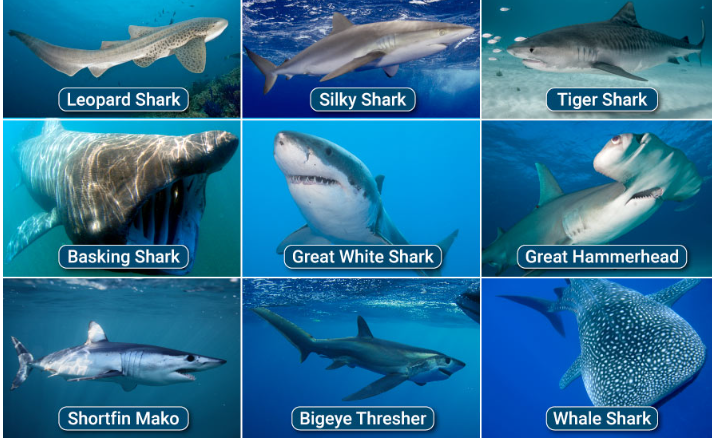
Sharks are one of the most fascinating creatures in the ocean—often misunderstood but undeniably intriguing. These apex predators come in all shapes and sizes, each with unique characteristics and behaviors. From the infamous Great White to the bizarre Goblin Shark, let’s dive into the depths of the ocean to explore the different Types of Sharks and what makes each species so special. So, are you ready to swim with the sharks?
Understanding the World of Sharks & Types of Sharks
Sharks have been around for over 400 million years, making them older than dinosaurs! With over 500 species, they range from the tiny Dwarf Lanternshark to the massive Whale Shark. But sharks aren’t just ocean monsters; they play a critical role in maintaining the balance of marine ecosystems. So, what types of sharks are out there, and how can you tell them apart?
The Most Recognizable Types of Sharks
Great White Shark (Carcharodon carcharias)
The Great White Shark is the rock star of the shark world—everyone knows its name. But did you know it can grow up to 20 feet long and weigh over 5,000 pounds? Great Whites are known for their torpedo-shaped bodies, sharp teeth, and incredible hunting skills. They’re found in coastal waters worldwide, often patrolling the shores of California, South Africa, and Australia. But despite their reputation, Great Whites are not mindless killers; they’re curious creatures that sometimes “test bite” things (unfortunately, including surfboards).
Hammerhead Shark (Sphyrnidae)
Hammerheads are like the weird cousin at a family reunion—unmistakable and unforgettable. With their distinct T-shaped heads, they have one of the most unique looks in the shark kingdom. But those heads aren’t just for show; they give Hammerheads a panoramic view of their surroundings, making them excellent hunters. You’ll find these sharks in warm waters worldwide, from Florida to the Galápagos Islands, often hunting stingrays, their favorite snack.
Tiger Shark (Galeocerdo cuvier)
Tiger Sharks are the garbage disposal of the ocean—they’ll eat just about anything, from fish and birds to old tires and license plates! These large, stocky predators can grow up to 16 feet and are easily identified by their tiger-like stripes. Found in tropical and subtropical waters, Tiger Sharks are known for their powerful jaws and insatiable appetites. They’re opportunistic hunters, meaning they aren’t too picky about what’s on the menu.
Bull Shark (Carcharhinus leucas)
Bull Sharks are the bodybuilders of the shark world—muscular, aggressive, and able to thrive in both salt and freshwater. Yes, you heard that right! Bull Sharks can swim up rivers and have been found thousands of miles from the ocean, making them one of the most adaptable sharks. They have a reputation for being unpredictable, which is why they’re often considered one of the most dangerous shark species. But like all sharks, they’re not mindlessly aggressive; they’re just incredibly good at what they do.
The Gentle Giants
Whale Shark (Rhincodon typus)
Despite their name, Whale Sharks are not whales but are the largest fish in the sea, growing up to 40 feet long. Don’t worry, though—they’re gentle giants that feed on plankton and small fish by filter-feeding. These polka-dotted beauties are found in warm, tropical oceans and are a favorite among divers for their docile nature. Swimming alongside a Whale Shark is like floating next to a bus, but don’t be scared—they’re completely harmless!
Basking Shark (Cetorhinus maximus)
The Basking Shark is another gentle giant, the second largest shark in the ocean, reaching up to 26 feet in length. Like the Whale Shark, it’s a filter feeder that scoops up plankton while swimming with its mouth wide open. Found in temperate waters worldwide, these slow-moving sharks are often seen near the surface, “basking” in the sun. Despite their intimidating size, Basking Sharks are harmless to humans and are more interested in tiny sea critters than anything else.
The Bizarre and Lesser-Known Sharks
Goblin Shark (Mitsukurina owstoni)
The Goblin Shark is the stuff of nightmares—or science fiction! With its long, flattened snout and protruding jaws, this deep-sea dweller is one of the strangest sharks out there. Goblin Sharks are rarely seen, as they live in deep waters, usually below 300 feet. Their pinkish color, flabby bodies, and protrusible jaws make them look like something straight out of a horror movie. But don’t worry; you’re unlikely to encounter one unless you’re a deep-sea explorer.
Frilled Shark (Chlamydoselachus anguineus)
Meet the living fossil—the Frilled Shark. With its eel-like body, frilled gills, and prehistoric appearance, this shark hasn’t changed much since the age of dinosaurs. It’s a deep-sea species, often found at depths of around 3,300 feet. Its needle-like teeth and serpent-like movements make it a formidable predator of the deep. But you won’t see this one near the beach; it’s a creature of the ocean’s dark, mysterious depths.
Wobbegong Shark (Orectolobidae)
Wobbegongs are the masters of disguise in the shark world. Often referred to as “carpet sharks,” they blend into the ocean floor with their intricate patterns and colors, waiting to ambush prey. Found in the shallow waters of Australia and Southeast Asia, Wobbegongs are not built for speed but for stealth. They’re often so camouflaged that divers might accidentally step on them—a mistake you definitely want to avoid!
Why Sharks Are Important to Our Oceans
Sharks aren’t just ocean predators; they’re crucial to marine ecosystems. By controlling the populations of other species, sharks help maintain the balance of the food chain. Think of them as the ocean’s cleanup crew, removing weak and sick animals from the population. Without sharks, the marine ecosystem would be in chaos, leading to overpopulation of certain species and depletion of others. In short, sharks keep the ocean in check.
Shark Conservation: Protecting the Ocean’s Apex Predators
Sharks are facing serious threats from overfishing, habitat loss, and the fin trade. Many species are now endangered, and their populations are declining at alarming rates. Organizations worldwide are working tirelessly to protect these incredible animals through marine reserves, stricter fishing regulations, and public awareness campaigns. Want to help? You can support shark conservation by choosing sustainable seafood, reducing plastic use, and supporting organizations dedicated to shark preservation.
Conclusion
Types of Sharks are some of the most misunderstood creatures on Earth. From the iconic Great White to the bizarre Goblin Shark, each species plays a unique role in our oceans. They’re not mindless monsters but fascinating, complex animals that deserve our respect and protection. So, the next time you think of sharks, remember—they’re not just predators; they’re essential guardians of the sea, keeping our oceans healthy and vibrant.
Whether you’re a shark enthusiast or just curious about the ocean’s most famous predators, there’s always more to learn. So, dive in, explore, and discover the incredible world of sharks—you might just find a new appreciation for these ancient, awe-inspiring creatures.



